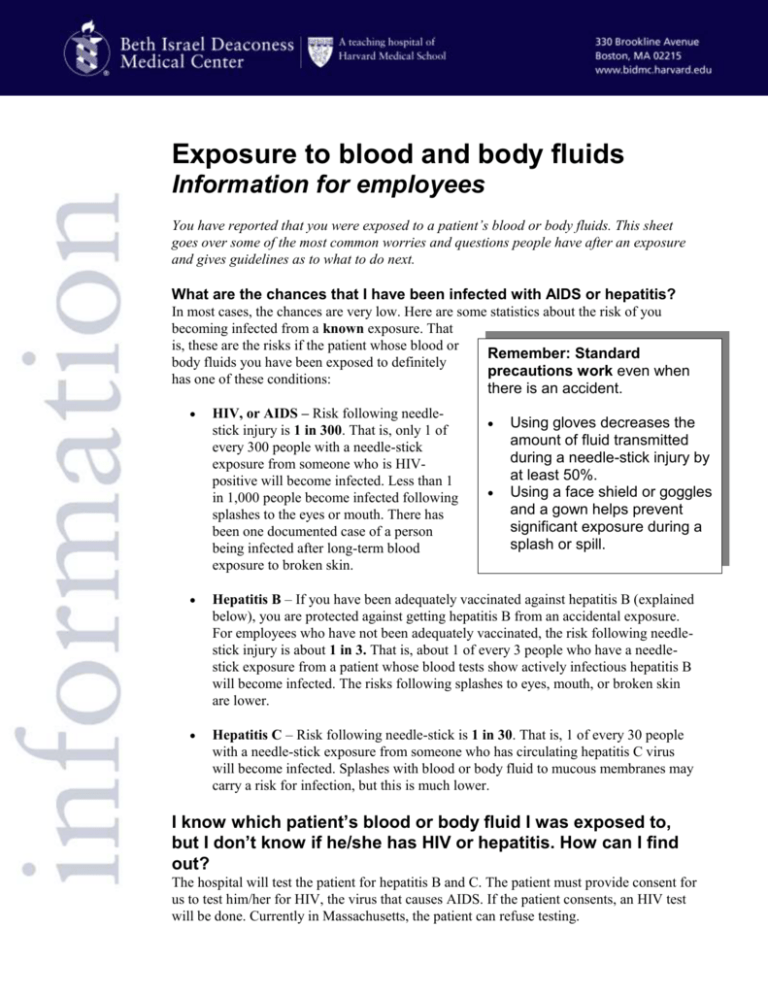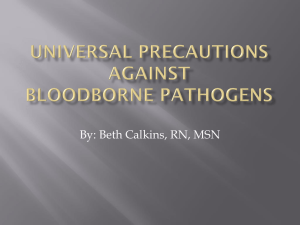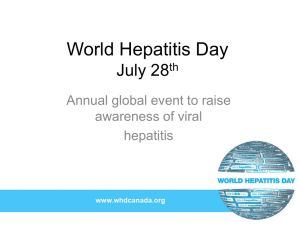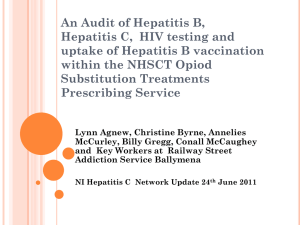
Exposure to blood and body fluids
Information for employees
You have reported that you were exposed to a patient’s blood or body fluids. This sheet
goes over some of the most common worries and questions people have after an exposure
and gives guidelines as to what to do next.
What are the chances that I have been infected with AIDS or hepatitis?
In most cases, the chances are very low. Here are some statistics about the risk of you
becoming infected from a known exposure. That
is, these are the risks if the patient whose blood or
Remember: Standard
body fluids you have been exposed to definitely
precautions work even when
has one of these conditions:
there is an accident.
HIV, or AIDS – Risk following needlestick injury is 1 in 300. That is, only 1 of
every 300 people with a needle-stick
exposure from someone who is HIVpositive will become infected. Less than 1
in 1,000 people become infected following
splashes to the eyes or mouth. There has
been one documented case of a person
being infected after long-term blood
exposure to broken skin.
Using gloves decreases the
amount of fluid transmitted
during a needle-stick injury by
at least 50%.
Using a face shield or goggles
and a gown helps prevent
significant exposure during a
splash or spill.
Hepatitis B – If you have been adequately vaccinated against hepatitis B (explained
below), you are protected against getting hepatitis B from an accidental exposure.
For employees who have not been adequately vaccinated, the risk following needlestick injury is about 1 in 3. That is, about 1 of every 3 people who have a needlestick exposure from a patient whose blood tests show actively infectious hepatitis B
will become infected. The risks following splashes to eyes, mouth, or broken skin
are lower.
Hepatitis C – Risk following needle-stick is 1 in 30. That is, 1 of every 30 people
with a needle-stick exposure from someone who has circulating hepatitis C virus
will become infected. Splashes with blood or body fluid to mucous membranes may
carry a risk for infection, but this is much lower.
I know which patient’s blood or body fluid I was exposed to,
but I don’t know if he/she has HIV or hepatitis. How can I find
out?
The hospital will test the patient for hepatitis B and C. The patient must provide consent for
us to test him/her for HIV, the virus that causes AIDS. If the patient consents, an HIV test
will be done. Currently in Massachusetts, the patient can refuse testing.
What should I do while the hospital is waiting for the results
from the patient?
Staff in employee occupational health services (EOHS) will talk with you about whether or
not you need treatment now to help prevent possible transmission of hepatitis or HIV. (See
“Treatment following exposure,” below). This will depend on the type of exposure that
you had, and also on the likelihood of the patient having hepatitis or HIV. (If your exposure
occurred when EOHS is closed, you will be seen by staff in the emergency department, in
consultation with a doctor specializing in infectious diseases.)
I don’t know which patient I was exposed to. What should I do?
First, it’s important to remember that this kind of exposure does not mean you will
necessarily contract HIV or hepatitis. (See statistics noted above.) But to be safe, we can
offer treatment under certain circumstances. This treatment is described in the next section.
Treatment following exposure
Protection against HIV - Studies have shown that you can reduce your risk of
infection with HIV by taking anti-viral medications soon after your exposure.
Depending on the type of exposure you had, you may be offered 2, 3, or more
medications. You will be given a drug information sheet about side effects for the
actual medicines you will take.
In general, medication to protect against HIV is offered when there has been a
significant exposure and:
you know the patient you were exposed to has HIV, or
you are waiting for test results on a patient who may be at risk for
having HIV, or
you know who the patient was, but he/she is refusing an HIV test and
may be at risk for having HIV, or
you don’t know who the patient was
Protection against hepatitis B – Most employees have had a vaccination against
hepatitis B and have had a blood test to see if the vaccine was effective. If your
medical record shows that you have had an effective vaccination against hepatitis B,
you are immune and will not need any treatment.
In some people, the hepatitis B vaccine does not produce immunity. If this happened
to you, you are still at risk for the disease. If your blood tests show that you are still
at risk, you will be given a medicine called hepatitis B immune globulin (HBIG)
which provides protection against this exposure only.
If you have never had the hepatitis vaccine, it will be offered to you now.
Why do I need my own blood tested?
There are two main reasons. First, if you’ve been vaccinated against hepatitis B, we will
make sure the vaccine is working well. If it is not, we may call you back for further
treatment against this illness. This will mean a vaccine booster and/or a dose of hepatitis B
immune globulin (HBIG).
The second reason is to have a record of whether or not you were infected in the past with
hepatitis or HIV. Some people have been infected with these illnesses and don’t know it.
With your consent, we will test you for HIV and hepatitis. If these tests come back positive,
it is not because of the exposure you just had. It means you were exposed at some time in
the past. We will talk with you about what to do next.
If the tests are negative, we will follow your results over time and be able to tell whether or
not you became infected from your exposure today.
What should I tell my family and loved ones? Am I putting them
at risk?
It is very important to remember that HIV and hepatitis are passed to others only through
blood or body fluids. None of these illnesses are passed along by casual contact. In some
cases where we are concerned that you may have been exposed to HIV or hepatitis, we will
advise you to practice safer sex while we wait for needed test results. This means using a
condom when you have sex. You should also avoid sharing toothbrushes or razors during
this period. Talk with the staff in EOHS about whether these precautions apply to you.
What about follow-up care?
Your care is coordinated by employee occupational health services (EOHS). If your
exposure occurred during hours when EOHS is closed, you are first seen in the emergency
department. But you need to report to EOHS for follow-up the next business day.
During your first visit, staff in EOHS will tell you when you need to return for further
follow-up. You may be asked to come back in 6 weeks and then again in 3 months and 12
months. It is your responsibility to keep these follow-up appointments. In order to
protect your confidentiality, no test results are shared with your own doctor. If you’d like
your doctor to have a copy of your results, please let us know.
This material was prepared by clinicians in employee and occupational health services at Beth Israel Deaconess Medical
Center. It is produced and distributed by the Beth Israel Deaconess Learning Center. ©2007, Beth Israel Deaconess Medical
Center. All rights reserved. MC0798, Rev. 1/2007






